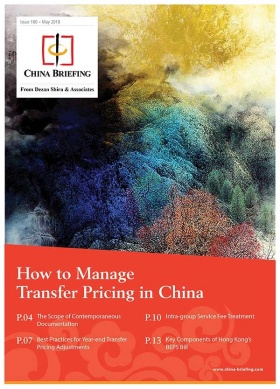How to Transfer a Work Permit to a New Employer in China
By Hugo Butcher Piat
For foreigners working in China, the work permit is a crucial document that must be attained prior to commencing work. The work permit is tied to your employer, which means that when changing jobs, you must first cancel the work permit with your previous employer, before applying for a new work permit with your new employer.
This “transfer” of an existing work permit from one employer to another usually takes around 4-6 weeks, though some applications may take up to 12 weeks to complete. Because the application process can be lengthy, it is best to be prepared for what lays ahead at each stage of the process.
Below, we outline the documents and steps required to complete this process.
What is a work permit?
There are two work visa categories in China: the Z Visa (Work); and the R Visa (High-level Talent). Each has a different scope and is granted according to the applicant’s background and the type of work he or she will be performing in China.
The key points are:
- Z Visa: Issued outside of China and needed to enter the country. Covers most work roles, both skilled and unskilled (including managerial, technical, research, and education).
- R Visa: Issued outside of China and needed to enter the country. Covers highly-skilled work roles (e.g. senior management and other high value positions).
- Work permit: This needs to be applied for after you have entered the country. Allows you to work legally in China.
- Residence permit: This needs to be applied for after you have entered the country. Allows you to reside in China and to travel in and out of the country an unlimited number of times (during validity).
Your visa and residence permit are both affixed inside your passport. The work permit is a separate laminated card, much like a driver’s license. This is the document that we will focus on here.
Keep in mind that as of April 2017, a new work permit system was implemented across China. Since then, the overall process and documentation required for foreigners applying for a work permit or visa has been revised. These revisions aim at adopting an online type database to increase efficiency. Such changes tend to take effect gradually rather than immediately.
![]() RELATED: HR and Payroll in China: Eight Quick Tips That Can Make a Difference
RELATED: HR and Payroll in China: Eight Quick Tips That Can Make a Difference
Transfer your work permit in two steps
Step 1: Cancel the current work permit
To transfer your work permit to a new employer, you first need to cancel your current or previous work permit.
To do this, notify your current employer to cancel your work permit. The employer will have access to the online system and can access the appropriate cancellation forms via their account.
The relevant forms are:
- “Application Form for Cancellation of Foreigner’s Work Permit”; and
- “Proof of Cancellation of Work Permit for Foreigners Working in China”.
A work permit will be canceled if it has:
- Been canceled on request (by employee);
- Expired and has not been renewed; or
- Been revoked by the government bureau in charge.
A former employer should apply for cancellation of a work permit within 10 working days from when an employment relationship ceases. So for past work, in most cases you can expect that the cancellation has already taken place.
Note that the reason for cancellation of the work permit will be included on the cancellation certificate. So, consider your relations with your current or previous employer and consider the future impact of any negative information that may be included here.
Step 2: Apply for a new work permit
The two key documents that your new employer will need to apply for here are:
- “Notification Letter of Foreigner’s Work Permit in China”; and
- “Foreigner’s Work Permit”.
However, the application is slightly different depending on whether the applicant’s new position is in the same field or a different one. So, you will need to determine whether or not your occupation will change at the time of your transition.
Consider whether you will have either:
Option A: A new employer and the same occupation
This means you can stay in China during the application process and will not need to apply for a new Z or R visa. However, your residence permit must still be valid at the time of application for you to remain in China for the duration of the transfer.
Option B: A new employer and a new occupation
This means you must leave China and re-enter on a new Z or R visa. This option differs from the first since it requires those documents relevant to proving that you are qualified for the new occupation. These include relevant certificates and employment history related to the new occupation.
What defines a ‘new occupation’ has not been made explicitly clear by the authorities. However, it can be deduced, for example, that if you are currently an English teacher and your new occupation will be as a consultant, naturally the requirements and work experience for the new role will be different. So, consider whether or not the nature of the new role differs from the current or previous one.
If you are still unsure, it is best to contact your local Entry and Exit Bureau or Labor Bureau as local requirements may differ and the local authority will ultimately make the decision.
Documents required
The following documents should be provided to your employer as you prepare to apply for your new work permit. You will need to provide:
- Application form for Foreigner’s Work Permit;
- Verification of past employment (not required if occupation will remain the same);
- Criminal record certificate (issued within last 6 months);
- Physical examination record for foreigner or overseas Chinese;
- Copy of the job contract or appointment letter (from new employer);
- Passport;
- ID photo;
- Information of accompanying members; and
- Letter of Cancellation from your previous employer.*
*The letter of cancellation is not required in some regions. Also, if you obtained your current work permit after the new work permit card system was introduced in April 2017, then you will not require this document.
![]() HR and Payroll Services at Dezan Shira & Associates
HR and Payroll Services at Dezan Shira & Associates
As mentioned above, the transfer process can take anywhere from 4-12 weeks to complete. In general, it takes five working days for the initial application to be accepted for processing; 10 working days for the authorities to review the application materials; and 10 working days for the new work permit to be approved and issued. For high-level talents (Tier A applicants), the latter two steps take five days each.
In practice, however, the transfer process often takes longer, particularly if the applicant is required by the authorities to submit additional materials. The time frame is also affected by extraneous factors such as the number of applications the bureau must process.
Common pitfalls
Some companies are not eligible to employ foreigners. Make sure to confirm with your new employer whether or not they have a Foreign Work Permit System account and whether or not they are capable of hiring foreigners at all.
The point here is to do your homework before giving notice at your current role. If you are unsure about how to engage your new employer on this point it would be wise to take the approach that you are keen to understand everything about the permit process prior to making any commitments, as one should be. Be direct with your employer since you are the one who will lose out if your inquiries are not thorough enough.
It may be the case that some employers or workplace staff are difficult to get along with. This is generally out of one’s control. However, since the Chinese work permit is effectively tied to your employer, it is in your interest to keep relations with your employer civil, especially if difficulties arise.
Never break a contract illegally and refrain from engaging in behavior that may be construed as negative. Both instances above may be recorded against you at the time that your work permit is canceled. Such information may hinder future work permit applications.
From the employer’s perspective, properly managing and documenting the work permit transfer process decreases exposure to a labor dispute with the departing employee. A departing employee whose work permit transfer gets rejected by the authorities, for example, may blame his or her former employer for the result. Employers may enlist the services of a third party to assist in managing the work permit transfer process and reduce exposure to potentially damaging labor disputes.
About Us
China Briefing is published by Asia Briefing, a subsidiary of Dezan Shira & Associates. We produce material for foreign investors throughout Asia, including ASEAN, India, Indonesia, Russia, the Silk Road, and Vietnam. For editorial matters please contact us here, and for a complimentary subscription to our products, please click here.
Dezan Shira & Associates is a full service practice in China, providing business intelligence, due diligence, legal, tax, accounting, IT, HR, payroll, and advisory services throughout the China and Asian region. For assistance with China business issues or investments into China, please contact us at china@dezshira.com or visit us at www.dezshira.com
- Previous Article The Mental Healthcare Industry in China
- Next Article Fraud in China: Where is Your Company Losing Money?






